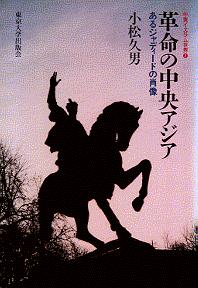 | The Project's Home | The Top Page of 1-A Group | Contents of 1-A Group
| The Project's Home | The Top Page of 1-A Group | Contents of 1-A Group
 | The Project's Home | The Top Page of 1-A Group | Contents of 1-A Group
| The Project's Home | The Top Page of 1-A Group | Contents of 1-A Group
The Project Has Started !
The first study meeting on June 14, 1997.reported by MATSUMOTO Hiroshi
The First 1-a Group Meeting with Book Review:

The Group 1-a has held the study meeting at the Annex Building of the Faculty of Art at Tokyo University, which is the Project Headquarters, on June 14th, 1997. This was the first study meeting of the whole project.
The Group 1-A is planning several kinds of study meetings to hold as occasion calls, those subjects are "issues and points," "thinkers," "areas," "book review" and "primary texts." As the first one of those, we have had the study meeting with book review. The book we studied is KOMATSU Hisao, Kakumei no Chuo Asia: Aru Jadid no Shozo (Central Asia in Revolution: The Portrait of a Jadid), Tokyo University Press, 1996, with Mr. KASUYA Gen as the reviewer.
The meeting was attended by not only the members of Group 1-a, which include the author of the book, but also the participants from Kyushu University and the other institutions. Thus, we were able to have a very active and positive discussion.
This book is the fruit that the author has been searching for two decades before the collapse of Soviet Union. Especially, considering the great deal of influence by the Glasnost' and the collapse of Soviet Union to his working, it can be said that this is the full work of years' labor. The author paid attention to Fitrat (1884? - 1938, born in Bukhara, executed during the Stalin era) as the thinker who manifested various aspects of his days, and the work described his life and time from a well-balanced point of view. It results in the author's success to make clear the wide view for subject and the historical and social situation of the Central Asia.
In the study meeting, we had several kinds of discussion concerning the viewpoints and contents of the book. We have mainly concentrated, however, on the below two issues:
The first was the special place of the Central Asia in the history of thought. Confirming the process of Fitrat's thought, from Islamic Reform and Pan-Islamism to Uzbek nationalism and Communism via Pan-Turkism, it is valued as the presentation of "another modernity in the Islamic world" by the participants.
The second was the general question of "what is a nation?" Was Uzbekistan created by the Uzbek literary and cultural movements led by Fitrat or by the reorganization of Central Asian nations by the Soviet Union? This was the most intent matter through all the participants from the concern of relations between the nation and the state or the creation of nations in modern times.
As it was a wide and deep discussion, very suitable for the first study meeting in "the Year to Discover Issues," we all got a great pleasure of sharing this exciting meeting.
Furthermore, this book review by Mr. KASUYA will be published in some academic journal in the near future.